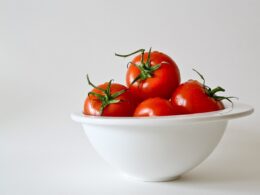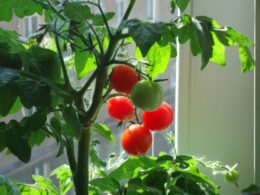You’ve been working hard to grow the perfect tomatoes in your garden, taking care to provide them with all the nutrients they need. But what happens if you don’t give them enough water?
In this article, we’ll explore the consequences of under-watering your tomato plants and how it can affect their health and fruit production. Your subconscious desire for safety will be satisfied as we guide you through early warning signs, long-term effects on fruit production, determining if your plants are getting enough water, properly watering techniques, and troubleshooting common issues.
Don’t let your hard work go to waste by depriving your tomato plants of the essential element they need – water. A lack of proper hydration can lead to a variety of problems that could ultimately affect not just the quality but also the quantity of tomatoes you harvest.
We’re here to help ensure that doesn’t happen so you can enjoy a bountiful and delicious crop from your garden. Read on to learn about what happens when tomatoes don’t get enough water and how you can prevent any potential issues from arising in your garden’s future.
Early Warning Signs of Under-Watering
You’ll start to notice your once vibrant and plump tomatoes beginning to wilt, their leaves turning yellow and edges curling as they desperately search for moisture. This is one of the earliest signs that your tomato plants are thirsty and need more water. If you see these symptoms, take action immediately!
Your plants will thank you, and you can prevent further damage. When under-watered, the growth of your tomato plants may slow down or even come to a halt. This can lead to smaller fruit or none at all if the problem persists. Don’t worry though – it’s easy to get them back on track with some simple adjustments in watering habits.
Make sure you’re giving them enough water by feeling the soil; it should be slightly damp but not soaking wet. Keep a close eye on your tomato plants during hot or dry spells, as they may require more frequent watering than usual.
By paying attention to these early warning signs and promptly addressing their needs, you’ll help ensure healthy growth and delicious tomatoes for your family to enjoy all season long. Remember: happy plants produce happy fruits – so keep those tomatoes hydrated!
Long-Term Effects on Fruit Production
So, what’s the deal with fruit production when our tomato plants are thirsty? Well, first off, if your tomatoes don’t get enough water, you’ll notice a significant decrease in the quantity and quality of the fruits they produce.
You see, water is crucial for the proper development of flowers and fruits on your tomato plants. Without enough water, your plants will struggle to develop their full potential, leaving you with fewer tomatoes that might not taste as good as they should.
Aside from affecting the size and flavor of your tomatoes, under-watering can also lead to other issues like blossom end rot or cracking. Blossom end rot is a calcium deficiency disorder caused by inconsistent watering that leads to darkened and decayed spots at the bottom of your fruit.
On the other hand, when your thirsty tomato plant finally gets a drink after being dehydrated for some time, it may absorb too much water too quickly causing the skin to crack.
So how do you avoid these issues and ensure a bountiful harvest of juicy tomatoes? The key is consistency in watering. Make sure to provide adequate moisture for your tomato plants throughout their growing season while avoiding over-watering.
By keeping an eye on soil moisture levels and adjusting as needed based on weather conditions or plant growth stage, you’ll be well on your way to enjoying delicious homegrown tomatoes all summer long!
Determining if Your Plants are Getting Enough Water
Imagine your tomato plants flourishing with just the right amount of water, their leaves a vibrant green and fruits plump and juicy. To achieve this ideal scenario, it’s crucial to know how to determine if your plants are getting enough water.
The good news is that there are some simple signs you can look for to make sure your tomatoes are adequately hydrated. First, take a close look at your tomato plant’s leaves. If they’re wilted or have a yellowish hue, it could be an indication that they’re not getting enough water.
Additionally, pay attention to the soil around your plants: it should be evenly moist but not soggy. You can also stick your finger about an inch into the soil; if it feels dry at that depth, it’s time to water your plants. Another useful tool is a moisture meter which is easy-to-use and helps in accurately measuring the moisture levels in the soil.
By keeping an eye on these indicators and adjusting your watering habits accordingly, you’ll be well on your way to nurturing healthy tomato plants with delicious fruit. Remember that consistency is key when watering – aim for even moisture throughout the growing season rather than sporadic heavy soakings followed by periods of drought.
With regular monitoring and proper watering techniques, you’ll protect those precious tomatoes from harm and enjoy bountiful harvests all summer long!
How to Properly Water Your Tomato Plants
Watering your tomato plants correctly is crucial for a healthy and fruitful harvest. Make sure to provide deep watering, as this encourages strong root growth and helps the plant access nutrients.
Use mulch to retain moisture around the base of your plants.
Pay attention to timing and frequency, aiming for consistent moisture levels in the soil without overwatering or allowing it to dry out completely.
The importance of deep watering
Deep watering plays a crucial role in ensuring healthy tomato plants, as it encourages a robust root system and helps prevent common issues that can arise from insufficient moisture.
By providing your tomatoes with a consistent supply of water deep into the soil, you’re not only helping them grow strong and resilient, but also promoting their overall well-being.
Some benefits of deep watering for your tomato plants include:
- Improved root development: A deep-rooted plant is more stable and can access moisture and nutrients from deeper soil layers.
- Reduced stress on the plant: Consistent moisture levels help prevent wilting and leaf curling, which can lead to reduced fruit production or even plant death.
- Better disease resistance: Adequate water supply helps keep your plants healthy, making them less susceptible to diseases like blight or fungus.
- Enhanced fruit quality: Proper hydration ensures plump, juicy tomatoes with fewer blemishes and cracks. So don’t skimp on watering – your taste buds will thank you!
Using mulch to retain moisture
You’ll find that using mulch to retain moisture is a game-changer in maintaining healthy, vibrant tomato plants while also easing your watering workload. Mulch acts as a protective layer on top of the soil, reducing evaporation and helping to maintain a consistent level of moisture. It’s like having a safety blanket for your tomatoes – you can worry less about constantly checking the soil and watering them frequently.
To use mulch effectively, simply spread a 2-3 inch layer around the base of your tomato plants. This not only helps with water retention but also suppresses weeds, regulates soil temperature, and reduces the risk of soil-borne diseases.
Organic mulches such as straw, grass clippings, or shredded leaves are great choices for tomatoes because they break down over time and add nutrients back into the soil.
So go ahead and give your precious tomato plants some extra love by providing them with this safe haven – they’ll thank you in return with an abundant harvest!
Timing and frequency of watering
It’s essential to understand the right timing and frequency for watering your tomato plants, as this plays a crucial role in their overall health and productivity.
Generally speaking, you should water your tomatoes once every two to three days during the growing season. However, this can vary depending on factors like temperature, humidity, and the size of your plants.
A good rule of thumb is to check the soil moisture by sticking your finger about an inch into the ground near the base of the plant. If it feels dry at that depth, it’s time to water.
When you do water your tomatoes, be sure to do so early in the morning or late in the evening. This helps prevent evaporation and ensures that your plants have plenty of moisture available when they need it most – during hot afternoon hours.
By following these simple guidelines for timing and frequency of watering, you’ll be able to keep your tomato plants well-hydrated and healthy throughout their growing season. And with healthy plants come bountiful harvests – ensuring that all-important sense of safety we all crave when providing food for ourselves and our loved ones!
Troubleshooting Common Watering Issues
Imagine your tomato plants struggling with common watering issues, leaving them thirsty and vulnerable to various problems. One of the most common issues gardeners face is over-watering or under-watering their tomato plants.
Over-watering can lead to root rot, while under-watering can cause wilting and weaken the plant’s immune system. To avoid these problems, keep an eye on your plants for any signs of distress and adjust your watering schedule accordingly.
If you notice yellow leaves on your tomato plants, this may be a sign of over-watering. In this case, cut back on the water and ensure that the soil drains well so that excess moisture doesn’t build up around the roots.
On the other hand, if you see curled or drooping leaves, it could be a sign of under-watering. In such cases, make sure to provide enough water for your plants by following a consistent watering schedule based on their needs and weather conditions.
To maintain healthy tomato plants, it’s essential to find the right balance when it comes to watering. Pay attention to how quickly the soil dries out after each watering session and adjust as needed.
A good rule of thumb is to water deeply once or twice a week during hot weather and less frequently during cooler periods. By taking proper care of your tomatoes’ hydration needs, you’ll help them thrive while avoiding potential issues caused by improper watering practices.
Conclusion
So, if you don’t give your tomatoes enough water, they’ll show early warning signs and may have long-term effects on fruit production.
To avoid these issues, make sure you’re properly watering your plants and troubleshooting any common problems.
Remember to monitor your plants closely and keep them well-hydrated. By doing so, you’ll ensure a bountiful harvest of delicious tomatoes for you to enjoy!









